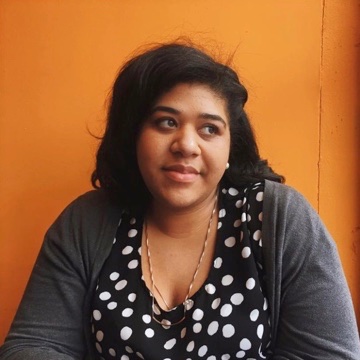Featured Prose | March 08, 2019

Interview with 2019 Miller Audio Prize Guest Judge Cher Vincent
Our guest judge this year, Cher Vincent (she/her), is an audio producer based in Chicago. She is currently Lead Audio Producer for One Illinois, a nonprofit news outlet, covering statewide news and producing two podcasts, Best People and In the Milkweeds. She is a co-founder of Postloudness, a podcast collective of audio shows by people of color, women, and queer-identified hosts that started in 2016. She was a 2017 Third Coast Radio Resident and has contributed stories to Gimlet Media, MTV News, BuzzFeed, Spotify, and NPR, and most recently executive produced an audio documentary on the life of Margaret T. Burroughs, founder of Chicago’s DuSable Museum, for the Terra Foundation. She is often told she is “delightful”.
TMR: How did you get into the audio/podcast world? What drew you to working with audio as a medium?
CV: I grew up in a household where radio and audio were very accessible. My father received his Bachelors in Broadcast and Communications in the late 70s, and was a radio engineer for most of the 80s and early 90s. By the time I was 5 however, my father changed careers and become a software engineer. But as long as I can remember, my father recorded conversations of my sister and I, interviewing us and creating radio shows, purely for his own entertainment. They highlighted our early childhood curiosities and ideas of the world around us, from our favorite bands at age 4, (mine was Queensryche), to hearing my sister and I fight about which character we were on a favorite TV show, (I was Spinelli on “Recess”).
After I finished college, I started to revisit those tapes, and began to use that early exposure to my advantage, creating podcasts, purely for my own entertainment. Eventually, after finishing grad school, I continued to make audio work, with people actually listening to it. I was a sixth grade science teacher by day, and on nights and weekends, was building an audio portfolio. I took the leap 3 years ago to go full-time as a radio producer and haven’t looked back since.
TMR: You’re the co-founder of Postloudness, which is a platform for audio shows hosted by people of color, women, and queer-identified artists. Can you tell us a little bit more about Postloudness and how that came to be?
CV: After grad school, I moved back to Chicago and began a podcast called “Open Ended,” with my best friend, James T. Green. We started it on a lark, mostly because we had been friends for years, and wanted to create something together. After a year of production, we had received many inquires from friends and colleagues to help them make their own shows. After some consideration, James and I, along with another Chicago producer, Alex Cox, started Postloudness. In a effort to create space for folks that were either first-time audio producers or independent producers that needed more support, we amplified their voices, shared practices, and allowed the collective to support one another. We saw an industry that was largely white and male dominated and wanted to offer an alternative.
TMR: How do you find stories for Best People and In the Milkweeds?
CV: Within One Illinois, our common goal is to bridge the rural and urban divide within Illinois. Most of the stories that we cover on Best People come from the long-form writing on the site and our video content, taking a much deeper dive on any given subject, albeit infrastructure or women’s health. For In the Milkweeds, each episode tackles an issue that concerns the season’s election. In the first season, the Illinois Midterm elections were covered, with a focus on the gubernatorial race. The issues covered affected the entire state like taxes, education, and healthcare. The second season focused on Chicago’s mayoral race, where there were 14 candidates, which ended on a run-off between two black women, resulting in a first ever for the city. Topics included gun-violence, corruption, and pensions, which are usually covered on a national level for Chicago. The key for In the Milkweeds, is for every week, try to break down these issues, present in a digestible way, and be a useful tool for voters that are single-issue, or have several issues, to know where these candidates land, and ideally, hold them accountable, once in office.
TMR: Out of all of the podcasts that you host and produce, what was your favorite episode(s) to work on? Why?
CV: I have so many favorites, from the “Moo & Oink” story for The Nod, to the entirety of Open Ended. But the first episode of Best People is still my favorite episode of the series, considering it nearly didn’t happen. At the time, we wanted to focus the episode on the mayor of Savanna, IL, which eventually became Episode 2. But after fighting for it, I was able to make our premiere episode about infrastructure. It isn’t the “sexiest” subject ever, but it’s so incredibly important. It’s my favorite because on a storytelling level, a bridge demolition shouldn’t work. But being able to make the bridge the character and centering its journey as a Depression-era public works project to its debilitated structure and iconic image to the town made all the hard work worth it.
TMR: You are also a photographer; how does that inform your audio work?
CV: Most of my photography stemmed from my early work in music journalism, producing podcasts for community and public radio on that beat for several years while pursing my Masters in Education. It was a way to have a visual component to the audio work I made. Most of my shots were hyper closeups, some pretty invasive, while musicians were on stage. I tried to have those same elements in the audio work I make, create very intimate moments while performing for larger audiences.
TMR: Some of the entrants into the TMR Miller Audio Prize are artists that typically call other mediums and genres home. What advice would you give to an artist just venturing into audio work?
CV: I think the beauty of audio is that is accessible and transferrable to other mediums. The threshold to making audio work is low compared to other mediums like video, but it is just as intensive and rewarding. As self-taught, I didn’t consider what I did in making audio work an “art practice” for many years, but as I produced more work, it became harder to ignore. My advice to anyone that is just beginning in audio is to make the work, take the time to learn to do it well, and like any other creative practice, look at the world and people around you for inspiration.
TMR: Where do you hope podcasts will take us in the future?
CV: Like everything else, more brown, more honest, and more experimental. In the higher caliber of podcast production, they all sound the same. I want more experimentation with a bigger budget. I want shows with black and brown folks on the mic, cutting the tape, and overseeing its impact. And lastly, I want the bigger networks and production houses to be more honest about what makes a show “a success”. That it isn’t about quantity of listeners, but quality.
TMR: What are some things that you love most about Chicago? Do you a have a favorite Chicago food?
CV: Chicago is my home, even when it wasn’t. I was born and raised here, and over the years, we have had our moments when I wanted to leave and never return. But the best part of Chicago is that no matter what you do or where you go, they will always receive you with open arms. As far favorite food: don’t be misguided about pizza, tacos are the best Chicago food. It’s perfect.
SEE THE ISSUE
SUGGESTED CONTENT

Featured Prose
Apr 19 2024
An Interview with Robert Long Foreman
Recently, TMR intern Shayla Malone interviewed Robert Long Foreman about “Song Night,” which tells the story of a pot-smoking father who has to adapt to the fact that his teenage daughter… read more

Featured Prose
Mar 22 2024
“Vegetable Stories” by Rohini Sunderam
In Rohini Sunderam’s “Vegetable Stories,” first published in TMR issue 45.3 (Fall 2022), an unconsummated romance buds, flourishes, withers, and endures in dormant form for two people who communicate their feelings… read more

Featured Prose
Mar 15 2024
An Interview with Genevieve Abravanel
Recently, TMR intern Shayla Malone interviewed Genevieve Abravanel about “Wilderness Survival,” which tells the story of a recently widowed mom and her young daughter, who becomes an avid follower of a… read more

